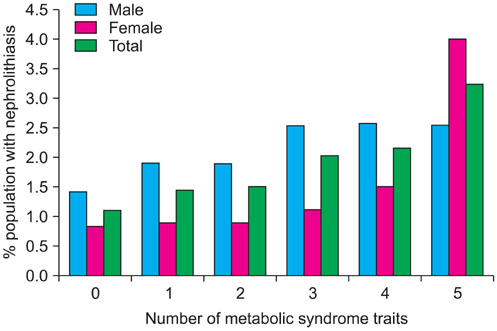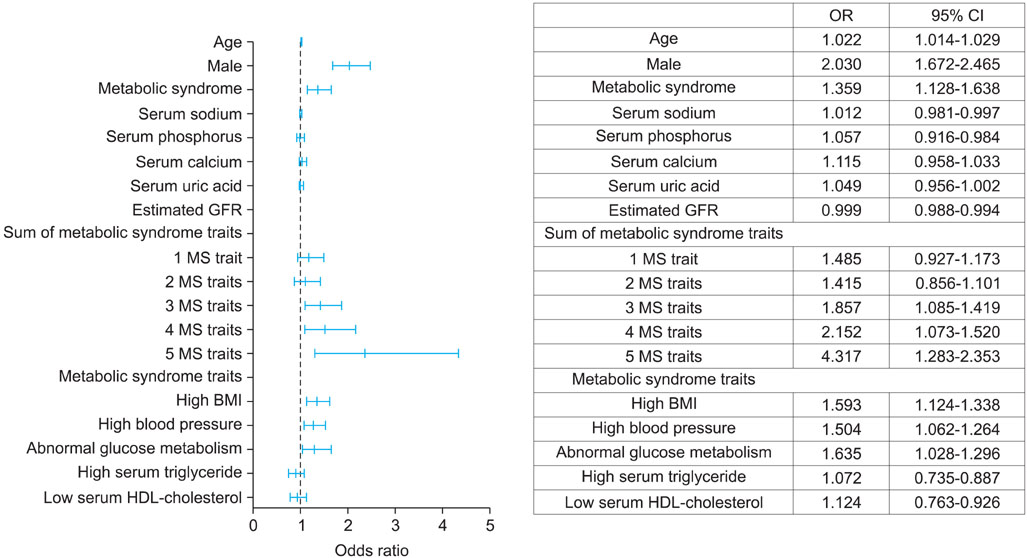Korean J Urol.
2011 Aug;52(8):548-553. 10.4111/kju.2011.52.8.548.
Possible Relationship between Metabolic Syndrome Traits and Nephrolithiasis: Incidence for 15 Years According to Gender
- Affiliations
-
- 1Department of Urology, Chung-Ang University College of Medicine, Seoul, Korea. caucih@cau.ac.kr
- KMID: 1988960
- DOI: http://doi.org/10.4111/kju.2011.52.8.548
Abstract
- PURPOSE
To analyze the independent effect of metabolic syndrome (MS) on nephrolithiasis (NL) despite differences in gender compared with the known lithogenic factors.
MATERIALS AND METHODS
From 1995 to 2009, 40,687 Koreans were enrolled in the study and observed for the development of NL at a health promotion center. The examination included anthropometric and biochemical measurements as well as kidney ultrasonography. A student's t-test or chi-square test was used to characterize the participants and a standard Cox proportional hazards model was used to calculate the adjusted odds ratio of lithogenic risk factors in the NL model.
RESULTS
The mean age of the study cohort was 44.9 years (range, 13-100 years), and 22,540 (55.4%) of the cohort was male. The incidence of NL was 1.5% (609 participants), with males exhibiting a higher incidence than females (1.9% vs 1.0%, p<0.01). Among the total cohort, MS as well as each trait of MS were risk factors for NL. In males, high body mass index (BMI), high blood pressure, and abnormal glucose metabolism were significant lithogenic factors, whereas in females, lithogenic factors included only high BMI and abnormal glucose metabolism.
CONCLUSIONS
MS is a significant lithogenic factor compared with other lithogenic factors. There was a correlated change in the prevalence of MS and NL and MS traits in Korea.
MeSH Terms
Figure
Reference
-
1. Stamatelou KK, Francis ME, Jones CA, Nyberg LM, Curhan GC. Time trends in reported prevalence of kidney stones in the United States: 1976-1994. Kidney Int. 2003. 63:1817–1823.2. Curhan GC. Epidemiology of stone disease. Urol Clin North Am. 2007. 34:287–293.3. Serio A, Fraioli A. Epidemiology of nephrolithiasis. Nephron. 1999. 81:26–30.4. Locatelli F, Pozzoni P, Del Vecchio L. Renal manifestations in the metabolic syndrome. J Am Soc Nephrol. 2006. 17:S81–S85.5. Chen J, Muntner P, Hamm LL, Jones DW, Batuman V, Fonseca V, et al. The metabolic syndrome and chronic kidney disease in U.S. adults. Ann Intern Med. 2004. 140:167–174.6. Park HS, Park CY, Oh SW, Yoo HJ. Prevalence of obesity and metabolic syndrome in Korean adults. Obes Rev. 2008. 9:104–107.7. West B, Luke A, Durazo-Arvizu RA, Cao G, Shoham D, Kramer H. Metabolic syndrome and self-reported history of kidney stones: the national health and nutrition examination survey (NHANES III) 1988-1994. Am J Kidney Dis. 2008. 51:741–747.8. Rendina D, Mossetti G, De Filippo G, Benvenuto D, Vivona CL, Imbroinise A, et al. Association between metabolic syndrome and nephrolithiasis in an inpatient population in southern Italy: role of gender, hypertension and abdominal obesity. Nephrol Dial Transplant. 2009. 24:900–906.9. Kim MS, Moon YT. The relationship between obesity and the risk factors of urolithiasis. Korean J Urol. 2007. 48:505–511.10. Jung TS, Yang WJ, Song YS. The correlation between metabolic syndrome and urinary pH in adult Korean men who visited a health promotion center. Korean J Urol. 2009. 50:694–698.11. Levey AS, Bosch JP, Lewis JB, Greene T, Rogers N, Roth D. Modification of Diet in Renal Disease Study Group. A more accurate method to estimate glomerular filtration rate from serum creatinine: a new prediction equation. Ann Intern Med. 1999. 130:461–470.12. Schepens D, Verswijvel G, Kuypers D, Vanrenterghem Y. Images in Nephrology. Renal cortical nephrocalcinosis. Nephrol Dial Transplant. 2000. 15:1080–1082.13. WHO Expert Consultation. Appropriate body-mass index for Asian populations and its implications for policy and intervention strategies. Lancet. 2004. 363:157–163.14. Romero V, Akpinar H, Assimos DG. Kidney stones: a global picture of prevalence, incidence, and associated risk factors. Rev Urol. 2010. 12:e86–e96.15. Prince CL, Scardino PL. A statistical analysis of ureteral calculi. J Urol. 1960. 83:561–565.16. Steemburgo T, Dall'Alba V, Gross JL, Azevedo MJ. Dietary factors and metabolic syndrome. Arq Bras Endocrinol Metabol. 2007. 51:1425–1433.17. Ford ES, Giles WH, Mokdad AH. Increasing prevalence of the metabolic syndrome among u.s. Adults. Diabetes Care. 2004. 27:2444–2449.18. Kamel KS, Cheema-Dhadli S, Halperin ML. Studies on the pathophysiology of the low urine pH in patients with uric acid stones. Kidney Int. 2002. 61:988–994.19. Abate N, Chandalia M, Cabo-Chan AV Jr, Moe OW, Sakhaee K. The metabolic syndrome and uric acid nephrolithiasis: novel features of renal manifestation of insulin resistance. Kidney Int. 2004. 65:386–392.20. Siener R, Glatz S, Nicolay C, Hesse A. The role of overweight and obesity in calcium oxalate stone formation. Obes Res. 2004. 12:106–113.21. Ripollés T, Agramunt M, Errando J, Martínez MJ, Coronel B, Morales M. Suspected ureteral colic: plain film and sonography vs unenhanced helical CT. A prospective study in 66 patients. Eur Radiol. 2004. 14:129–136.22. Ulusan S, Koc Z, Tokmak N. Accuracy of sonography for detecting renal stone: comparison with CT. J Clin Ultrasound. 2007. 35:256–261.23. Stevens J, Couper D, Pankow J, Folsom AR, Duncan BB, Nieto FJ, et al. Sensitivity and specificity of anthropometrics for the prediction of diabetes in a biracial cohort. Obes Res. 2001. 9:696–705.
- Full Text Links
- Actions
-
Cited
- CITED
-
- Close
- Share
- Similar articles
-
- Gender Difference in Association with Socioeconomic Status and Incidence of Metabolic Syndrome in Korean Adults
- The impact of uric acid and metabolic syndrome on the incidence of hypertention in a Korean population
- Clinical Significance of Hypocitraturia in Patients with Nephrolithiasis
- Epidemiology and economics of nephrolithiasis
- Enamel renal syndrome with associated amelogenesis imperfecta, nephrolithiasis, and hypocitraturia: A case report



